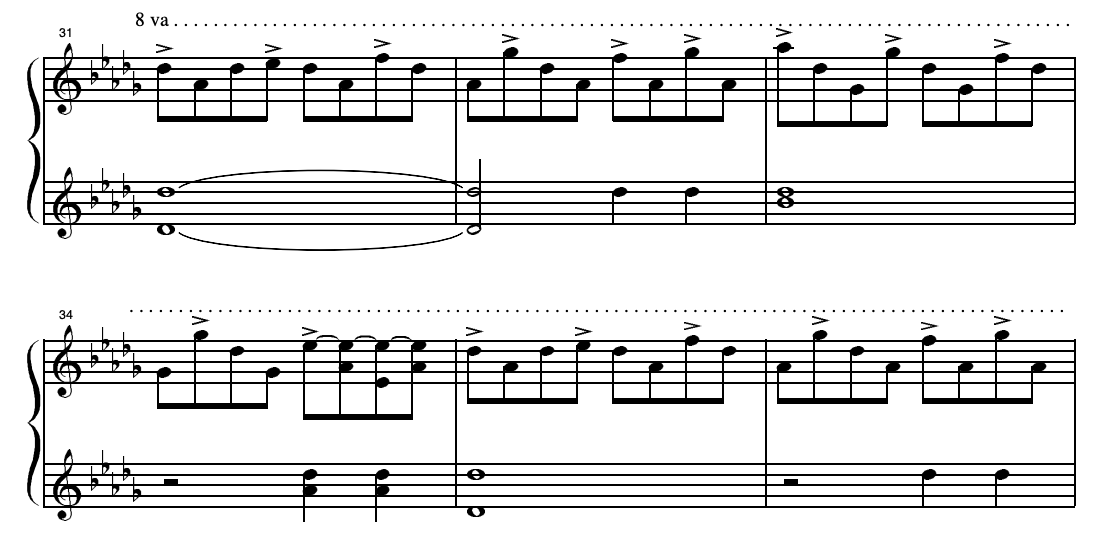Texture
How to thin out thick textures in your carillon arrangementCombining two voices into one
If the piece that you are trying to arrange was written for multiple instruments or voices, you will need to reduce or condense these voices in your carillon arrangement. An orchestra or band can play with many independent voices at the same time, but on the carillon, there are limitations, both physical and musical. A maximum of three independent voices will usually work best.
One way to reduce the number of independent voices is to merge two voices into one line, creating the illusion that the texture is thicker than it really is. Consider the following two examples:
Example 1: Beethoven - "Ich liebe dich"

The above excerpt shows the first four measures from the song "Ich liebe dich" by Beethoven. The voice sings the melody, while the piano plays a sixteenth-note accompaniment with the bass changing once per measure. To play all the sixteenth notes with one hand on the carillon, and the melody with the other hand is not only difficult, but would create a rather thick texture on the carillon for such a light, soft piece (especially if these sixteenth notes were kept in such a low register).
Carlo van Ulft, in his carillon arrangement of this piece, was able to avoid this by moving the sixteenth-note accompaniment up one octave, above the melody, and merging it with the melody line. This way, in the hands, there is never more than one note being struck at the same time, thus keeping the texture light and making it easier to bring out the melody.
Arrangement for carillon by Carlo van Ulft:

Example 2: Brahms - Intermezzo op. 118, no. 2
In the middle section of Brahms' Intermezzo op. 118, no. 2, it's possible to apply a similar technique. Measures 49-52 of the original piano piece are shown below:

The pick up to m. 49 is the start of the middle section of the Intermezzo. Brahms writes the melody in the right hand, while the left hand plays continuous triplets. The left hand line has several functions: it creates a rhythmical texture, suggests certain harmony and bass notes, and provides a counter melody (where the stems point up).
Such busy rhythms in such a low register will not work well on the carillon, but moving them up an octave or two into a higher register will help keep them lighter and let the melody come out. In the carillon arrangement of this passage below, the triplets are moved into the same register as the melody. Only the second and third triplets in each beat are kept, because there is always a melody note on the main beat. This creates the illusion of continuous triplets, while allowing the left hand to very quietly play the triplet accompaniment underneath the right hand melody. The pedal gets the countermelody.

Simplifying busy rhythms
This technique to simplify busy rhythms is best explained with an example. Let's consider the following excerpt from "All of Me" by Jon Schmidt:
All of Me by Jon Schmidt, original version:

All of Me is originally for the piano. The excerpt above is dominated by continuous eighth notes, with accents on certain beats to bring out a melody. If one were to transfer this directly to the carillon, the resulting score would be not only difficult or impossible to play at such a quick tempo, but it would also create a thick, heavy texture that doesn't suit the style of the original piece.
If we think about what elements are essential to this piece, a few come to mind: the (accented) melody, the bass, and the rhythmical drive. While the continuous eighth notes facilitate the rhythmical drive in the original piano version, they become a hindrance on the carillon.
Johan Van Audenhaege's carillon arrangement of this piece (excerpt below) presents a nice solution to this problem. He simplifies the rhythm by removing some of the continuous eighth notes, but preserving the melodic line. The resulting score is comfortably playable at a fast tempo and keeps the texture light, without losing the drive of the original piece.
Arrangement for carillon by Johan Van Audenhaege:


